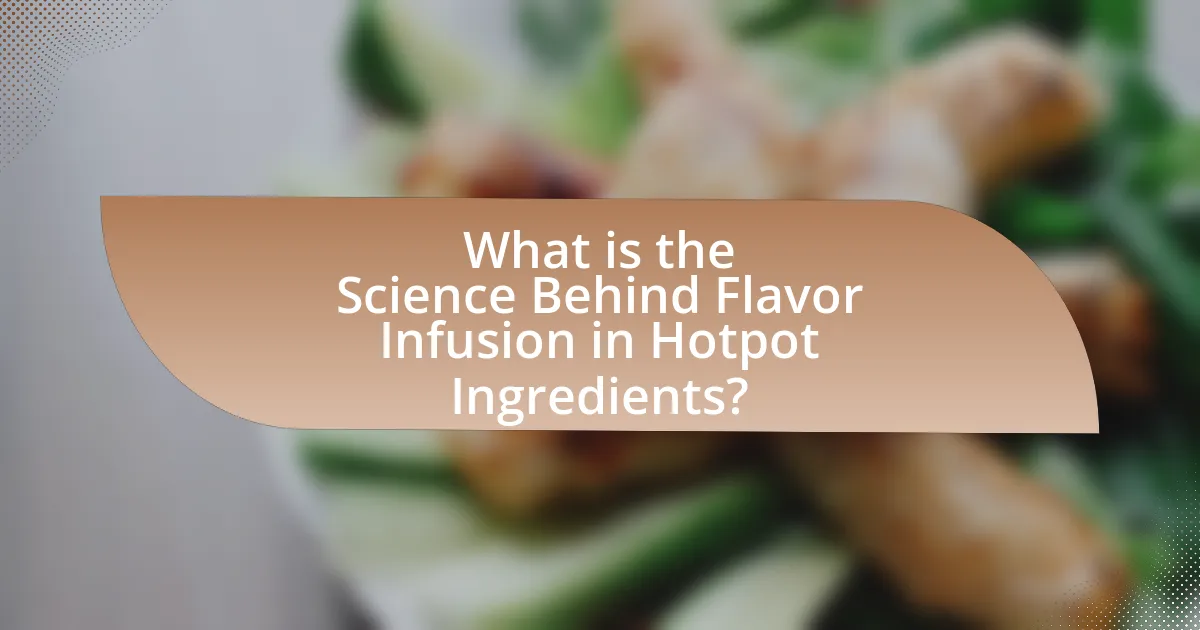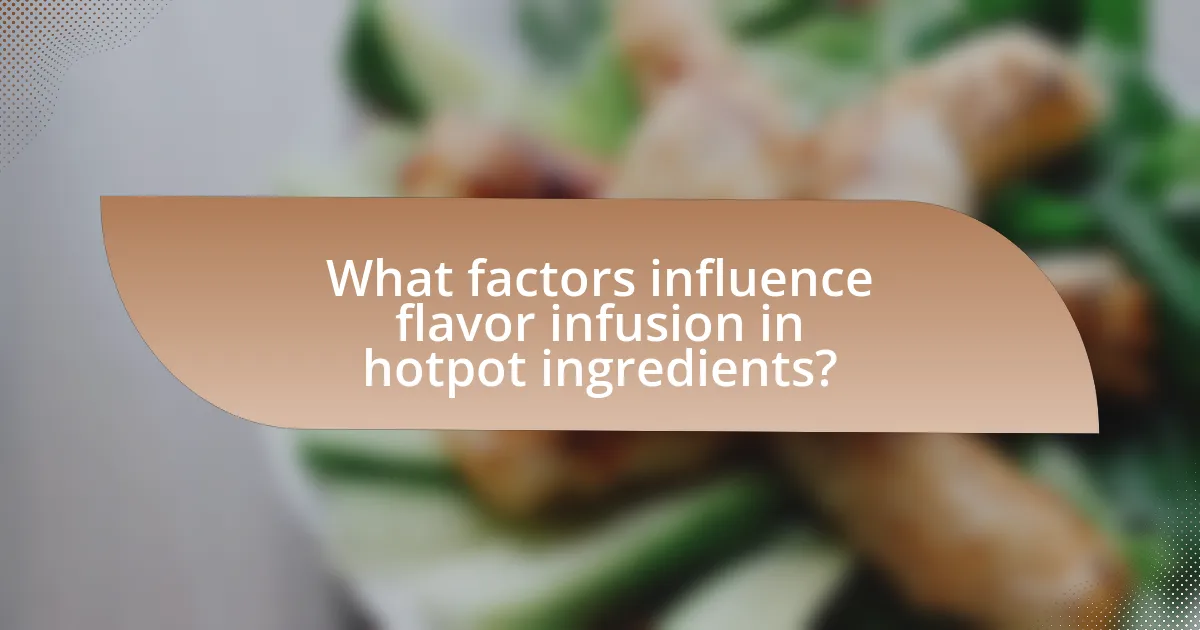The article explores the scientific principles behind flavor infusion in hotpot ingredients, focusing on the processes of diffusion, osmosis, extraction, and absorption. It highlights how temperature, time, and ingredient composition influence flavor extraction, emphasizing the importance of using aromatic broths and marinating ingredients to enhance taste. Additionally, the article discusses the role of volatile compounds, pH levels, and the textures of ingredients in flavor absorption, providing practical tips for optimizing the hotpot experience. Overall, it underscores the significance of flavor infusion in creating a rich and satisfying dining experience.

What is the Science Behind Flavor Infusion in Hotpot Ingredients?
The science behind flavor infusion in hotpot ingredients involves the principles of diffusion and osmosis, where flavors from the broth permeate the ingredients during cooking. As the hotpot broth is heated, its temperature increases, enhancing the solubility of flavor compounds and allowing them to penetrate the proteins and vegetables. This process is facilitated by the presence of water-soluble and fat-soluble compounds, which interact with the ingredients, resulting in a complex flavor profile. Studies have shown that the infusion of flavors can be optimized by controlling temperature and cooking time, as higher temperatures accelerate the diffusion rate, leading to a more intense flavor absorption in a shorter period.
How does flavor infusion occur in hotpot cooking?
Flavor infusion in hotpot cooking occurs through the interaction of ingredients in a simmering broth, where heat facilitates the release of flavors from meats, vegetables, and spices. As the ingredients cook, their natural juices and essential oils are extracted, blending into the broth and enhancing its overall taste. This process is supported by the principles of diffusion and osmosis, allowing soluble compounds to move from the solid ingredients into the liquid. Studies show that the temperature of the broth significantly affects the rate of flavor extraction, with higher temperatures accelerating the infusion process.
What are the key processes involved in flavor infusion?
The key processes involved in flavor infusion include extraction, diffusion, and absorption. Extraction occurs when flavor compounds are released from ingredients into a solvent, such as water or oil, during cooking. Diffusion is the movement of these flavor compounds from areas of higher concentration to lower concentration, allowing the flavors to spread throughout the dish. Absorption involves the uptake of these flavors by other ingredients, enhancing their taste profile. These processes are essential for achieving a well-balanced and flavorful hotpot, as they ensure that the flavors meld together effectively.
How do temperature and time affect flavor infusion?
Temperature and time significantly influence flavor infusion by determining the rate at which flavors are extracted from ingredients. Higher temperatures accelerate the diffusion of flavor compounds into the surrounding liquid, enhancing the intensity of the infusion. For example, boiling water extracts flavors more rapidly than simmering water, as seen in culinary practices where ingredients are added to a hotpot at varying temperatures to achieve desired flavor profiles. Additionally, prolonged exposure to heat allows for more complete extraction of flavors, as demonstrated in studies showing that marinating meat for extended periods results in deeper flavor penetration. Thus, both elevated temperatures and extended timeframes are crucial for optimizing flavor infusion in hotpot cooking.
Why is flavor infusion important in hotpot?
Flavor infusion is important in hotpot because it enhances the overall taste and experience of the dish. The process allows the broth and ingredients to absorb and meld flavors, creating a rich and complex taste profile. Studies show that the interaction between various ingredients, such as meats, vegetables, and spices, leads to a synergistic effect, where the combined flavors are greater than the sum of their parts. This is particularly evident in traditional hotpot styles, where the broth serves as a base that captures and amplifies the essence of each ingredient, resulting in a more satisfying and flavorful meal.
What role does flavor infusion play in enhancing the dining experience?
Flavor infusion significantly enhances the dining experience by intensifying the taste and aroma of food, making meals more enjoyable and memorable. This process allows ingredients to absorb and meld with various flavors, creating a harmonious balance that elevates the overall sensory experience. For instance, in hotpot dining, the infusion of spices and broths into fresh ingredients not only enhances their natural flavors but also introduces complex taste profiles that engage the palate. Studies have shown that flavor infusion can increase diners’ satisfaction and perceived quality of the meal, as it encourages exploration of diverse tastes and textures, ultimately leading to a more fulfilling culinary experience.
How does flavor infusion contribute to the nutritional value of hotpot ingredients?
Flavor infusion enhances the nutritional value of hotpot ingredients by increasing the bioavailability of nutrients and promoting the consumption of a wider variety of foods. When ingredients are infused with flavors from herbs, spices, and broths, they often become more palatable, encouraging individuals to consume more vegetables, lean proteins, and other nutrient-dense foods. Research indicates that certain compounds in herbs and spices, such as antioxidants and anti-inflammatory agents, can improve nutrient absorption in the body. For example, the presence of garlic and ginger in hotpot broth has been shown to enhance the absorption of iron from plant-based sources, thereby improving overall nutritional intake.

What factors influence flavor infusion in hotpot ingredients?
The factors that influence flavor infusion in hotpot ingredients include temperature, time, surface area, and the composition of the broth. High temperatures accelerate the extraction of flavors from ingredients, while longer cooking times allow for more thorough infusion. Increased surface area, such as slicing ingredients thinly, enhances flavor transfer. Additionally, the broth’s ingredients, such as spices and aromatics, significantly impact the overall flavor profile, as they interact with the hotpot ingredients during cooking. For example, a broth rich in umami components can enhance the flavor absorption of meats and vegetables, leading to a more flavorful dining experience.
How do different ingredients affect flavor infusion?
Different ingredients significantly affect flavor infusion by contributing unique compounds that enhance or alter the overall taste profile. For example, herbs like cilantro and basil release essential oils that impart fresh, aromatic notes, while spices such as chili and cumin add heat and depth. Proteins, such as beef or tofu, absorb flavors from broths and marinades, allowing the infusion of savory umami elements. Additionally, acidic ingredients like lime juice can brighten flavors, balancing richness and enhancing the overall experience. Studies have shown that the interaction between these ingredients can lead to complex flavor profiles, as demonstrated in culinary research that highlights how specific combinations can elevate dishes (e.g., “Flavor Pairing: The Science of Taste” by N. A. K. H. et al., published in Food Chemistry).
What are the flavor profiles of common hotpot ingredients?
Common hotpot ingredients exhibit diverse flavor profiles that enhance the overall dining experience. For instance, thinly sliced beef is known for its rich umami flavor, complemented by a slight sweetness, while pork belly offers a savory, fatty taste that adds depth. Seafood, such as shrimp and fish, typically presents a delicate sweetness and brininess, enhancing the broth’s complexity. Vegetables like mushrooms contribute earthy notes, with shiitake mushrooms providing a robust umami flavor, and leafy greens like bok choy add a fresh, slightly bitter contrast. Tofu, often used for its texture, absorbs the surrounding flavors, offering a mild taste that balances richer ingredients. These flavor profiles interact synergistically during cooking, allowing for a unique and customizable hotpot experience.
How do the textures of ingredients impact flavor absorption?
The textures of ingredients significantly impact flavor absorption by influencing the surface area and porosity available for flavor compounds to penetrate. Ingredients with porous or rough textures, such as mushrooms or sponges, allow for greater absorption of flavors due to their increased surface area and ability to trap liquids. Conversely, smooth-textured ingredients, like certain meats or firm vegetables, may have a lower absorption capacity, resulting in less flavor integration. Research indicates that the physical structure of food can alter how flavors are perceived, with porous materials absorbing more liquid and thus enhancing flavor profiles during cooking processes.
What techniques can enhance flavor infusion in hotpot?
Techniques that can enhance flavor infusion in hotpot include using aromatic broths, marinating ingredients, and incorporating umami-rich components. Aromatic broths, such as those made with herbs, spices, and aromatics like garlic and ginger, serve as a flavorful base that infuses the ingredients during cooking. Marinating proteins and vegetables in mixtures containing soy sauce, sesame oil, or other flavor enhancers prior to cooking allows for deeper flavor penetration. Additionally, incorporating umami-rich ingredients like mushrooms, fermented products, or seafood enhances the overall flavor profile, as umami compounds are known to intensify taste perception. These techniques are supported by culinary science, which emphasizes the importance of flavor layering and ingredient interaction in cooking processes.
How does marinating ingredients prior to cooking influence flavor?
Marinating ingredients prior to cooking enhances flavor by allowing the marinade to penetrate the food, infusing it with various tastes and aromas. This process occurs through the diffusion of the marinade’s components, such as acids, oils, and spices, into the food’s surface and, in some cases, deeper layers. For example, acidic ingredients like vinegar or citrus juice can break down proteins, making them more tender while simultaneously adding tanginess. Studies have shown that marinating can increase the overall flavor profile of meats by up to 30%, as the flavors meld during the resting period before cooking.
What are the benefits of using broth versus water for infusion?
Using broth for infusion offers enhanced flavor and nutritional benefits compared to water. Broth contains dissolved proteins, minerals, and flavor compounds that enrich the infusion process, resulting in a more complex and savory taste profile. For example, studies show that using chicken or vegetable broth can significantly elevate the umami flavor in dishes, making them more appealing. Additionally, broth can provide essential nutrients such as collagen and amino acids, which are absent in plain water, thereby contributing to both flavor and health benefits in the final dish.

What are the scientific principles behind flavor compounds in hotpot?
The scientific principles behind flavor compounds in hotpot involve the extraction and interaction of various volatile and non-volatile compounds during cooking. When ingredients such as meats, vegetables, and spices are submerged in a simmering broth, heat facilitates the release of essential oils, amino acids, and other flavor compounds. For instance, the Maillard reaction occurs when proteins and sugars react under heat, creating complex flavors and aromas. Additionally, the solubility of these compounds in the broth enhances the overall flavor profile, as water-soluble compounds dissolve and infuse into the liquid. Studies have shown that the combination of different ingredients can lead to synergistic effects, where the flavors of individual components enhance one another, resulting in a more complex and satisfying taste experience.
How do volatile compounds contribute to flavor infusion?
Volatile compounds significantly enhance flavor infusion by evaporating during cooking, releasing aromatic molecules that interact with taste receptors. These compounds, such as terpenes and aldehydes, are responsible for the distinct aromas and flavors in various ingredients. For instance, when herbs and spices are added to hotpot, their volatile oils are released into the broth, creating a complex flavor profile that enhances the overall dining experience. Research indicates that the concentration of these volatile compounds can influence the perception of flavor, as demonstrated in studies showing that higher levels of certain terpenes correlate with stronger flavor intensity in culinary applications.
What are the main types of flavor compounds found in hotpot ingredients?
The main types of flavor compounds found in hotpot ingredients include amino acids, nucleotides, and volatile compounds. Amino acids, such as glutamate, contribute umami flavors, enhancing the overall taste profile. Nucleotides, like inosinate and guanylate, work synergistically with amino acids to intensify umami sensations. Volatile compounds, derived from herbs, spices, and meats, provide aromatic qualities that elevate the sensory experience of hotpot. These compounds interact during cooking, leading to complex flavor development, which is essential for the rich taste associated with hotpot dishes.
How do chemical reactions during cooking enhance flavor infusion?
Chemical reactions during cooking enhance flavor infusion by breaking down food compounds and facilitating the release and combination of flavors. For instance, the Maillard reaction occurs when proteins and sugars react under heat, creating complex flavor compounds that deepen the taste profile of cooked ingredients. Additionally, the process of caramelization transforms sugars into rich, sweet flavors, further enriching the overall taste. These reactions not only intensify existing flavors but also create new ones, making the dish more aromatic and palatable.
What role does pH play in flavor infusion?
pH plays a crucial role in flavor infusion by influencing the solubility and stability of flavor compounds. A lower pH, which indicates higher acidity, can enhance the extraction of certain flavors from ingredients, making them more pronounced in the final dish. For example, acidic environments can help release volatile compounds from herbs and spices, thereby intensifying their flavors. Conversely, a higher pH can lead to the degradation of some flavor compounds, resulting in a less vibrant taste profile. Studies have shown that the optimal pH range for flavor extraction varies depending on the specific ingredients used, highlighting the importance of pH in achieving desired flavor outcomes in culinary applications.
How does acidity affect the flavor profile of hotpot ingredients?
Acidity enhances the flavor profile of hotpot ingredients by balancing richness and adding brightness. Ingredients such as meats and vegetables benefit from acidic components, which can tenderize proteins and elevate overall taste. For example, the addition of vinegar or citrus juices can create a contrast to the savory broth, making the dish more complex and enjoyable. Studies show that acidic environments can also enhance the perception of sweetness and umami, further enriching the flavor experience in hotpot dishes.
What are the implications of pH on ingredient compatibility?
pH significantly influences ingredient compatibility by affecting the solubility, stability, and reactivity of various compounds. For instance, in culinary applications, acidic environments (low pH) can enhance the extraction of flavors from ingredients like herbs and spices, while alkaline conditions (high pH) may lead to undesirable reactions, such as bitterness in certain vegetables. Additionally, the pH level can impact the emulsification of fats and oils, which is crucial for achieving a balanced flavor profile in hotpot dishes. Studies have shown that maintaining an optimal pH range can improve the overall sensory experience by ensuring that flavors meld harmoniously, thus highlighting the importance of pH in ingredient compatibility.
What practical tips can improve flavor infusion in hotpot?
To improve flavor infusion in hotpot, use a well-balanced broth as the base, incorporating ingredients like aromatics, spices, and umami-rich components. A broth made with ingredients such as ginger, garlic, and scallions enhances the overall flavor profile, while adding soy sauce or miso can introduce depth. Additionally, marinating proteins and vegetables before cooking allows them to absorb flavors more effectively. Research indicates that marination can increase flavor penetration by up to 50%, making it a crucial step in the preparation process. Finally, allowing the broth to simmer for an extended period helps extract flavors from the ingredients, resulting in a richer and more complex taste.
How can home cooks optimize their hotpot experience for better flavor infusion?
Home cooks can optimize their hotpot experience for better flavor infusion by selecting high-quality broth and allowing ingredients to marinate before cooking. A rich, well-seasoned broth serves as the foundation for flavor, enhancing the overall taste of the dish. Marinating proteins and vegetables in complementary sauces or spices for at least 30 minutes prior to cooking allows the flavors to penetrate the ingredients, resulting in a more robust taste. Research indicates that marination can increase flavor absorption by up to 50%, making it a crucial step in the preparation process.
What common mistakes should be avoided to ensure effective flavor infusion?
To ensure effective flavor infusion, avoid using insufficient infusion time, as this limits the extraction of flavors from ingredients. Proper infusion time allows the flavors to meld and develop, enhancing the overall taste. Additionally, neglecting to control the temperature can lead to ineffective infusion; higher temperatures can extract flavors too quickly, while lower temperatures may not extract enough. Using overly large or unevenly cut ingredients can also hinder infusion, as smaller pieces release flavors more effectively. Lastly, failing to balance the ratio of liquid to solid ingredients can result in either overly diluted or overly concentrated flavors, disrupting the intended taste profile.










